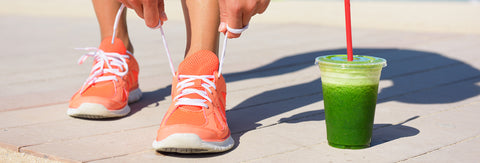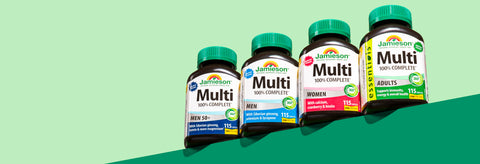Struggling with weight loss? Forget the fad diets and focus on the fundamentals.
Today, over two-thirds of the Canadian population are classified as overweight or obese.1 Weight worsens chronic health problems like high blood pressure, high blood sugar levels, chronic pain and inflammation, and the like. It’s also problematic for your mental health as well. Individuals with consistently higher blood sugar levels are at much greater risk of low mood.2-4
Also, the frustrating challenge with weight loss is that ‘feedback’ is not immediate. You can be making all the right changes - incorporate better dietary habits, exercise more - but because there is often a delay before significant results are seen, some get frustrated and change course. Ultimately, this leads to a shotgun approach to diet and exercise, chasing short-term ‘band-aid’ fixes at the expense of long-term success.
How can you start to reverse this trend? Here are five key principles to help you better understand the weight loss process and start building a more solid foundation for lasting success.
Let’s explore.
Your Metabolism Matters
Your resting metabolic rate (RMR) – the calories required to pump your heart, ventilate your lungs and keep you alive – accounts for between half to two-thirds of all the calories you burn in a day. (That’s a lot!) To put this into perspective, your physical activity accounts for only 20-30% (more on this below).5
Why does this matter? Chronic stress, lack of sleep, excessive caloric restriction (or even exercise) all lower your RMR, significantly reducing your RMR (and thus the number of calories you burn daily).6
Pro tip: If weight loss (and subsequent better health) is a goal for you, prioritize getting at least seven hours of sleep nightly. This improves your recovery, resilience and intense cravings that can occur when rundown, helping to preserve your RMR.
Don’t Dramatically Cut Calories
A steep drop in caloric intake isn’t just bad for your RMR, it also accelerates burning off muscle mass for energy. This is highly problematic for health and weight loss. Why? The more steeply you reduce caloric intake, the more muscle mass you’ll lose as a result.7
When you dramatically reduce calories and lose weight fast, you’re mostly losing muscle mass, glycogen (carbohydrate stores in muscle) and water. But, because the scale goes down, you feel like you’re making progress. Sadly, you’re not.
Worse yet, if you go back to eating properly, the scale will go up and you’ve unconsciously reinforced that doing things ‘the right way’ doesn’t work.
Pro tip: People often try and lose weight eating as little as possible. Major mistake. You always want to lose weight eating as much food as possible. Why? To preserve RMR and thus allow you to maintain progress over the year (and not just the first 30 days!). A good weekly weight loss target is 1-2% of your bodyweight.8
Daily Movement Matters
The daily movement you get in your typical day, the scientific term is non-exercise activity thermogenesis (NEAT) , is one of the best predictors of maintaining a healthy bodyweight.
During the covid19 pandemic, many people experienced a significant drop in daily steps (as the commute from the kitchen to the living room is not too far!)
How many steps do you need per day? A good rule of thumb is between 8-12k steps daily.9
Pro tip: Track your steps for a few weeks and see where you land on a typical day. If you’re short of the 8k steps, here are a few suggestions to get you moving: take a 20-minute morning walk upon rising, consider walking meetings at work, park further away from the door at shops, take an evening walk after dinner with your family or partner.
Build Your Meals Around Protein
Protein is the building block of life. Moreover, as you increase protein intake you significantly increase your micronutrient intake, as protein is a dense source of key vitamins and minerals for health, energy, and recovery.10
For weight loss, protein has the added benefit of ‘costing’ your body more calories just to breakdown and digest, a process called the ‘thermic effect of food’ (TEF). The TEF for protein is 3-4x higher than that of carbohydrates and fats.11
Pro Tip: What is a good target for daily protein intake? I suggest patients aim for 1.2g per kilogram bodyweight, per day. For example, an 80kg person would aim for 96g of protein daily (80kg x 1.2g/kg/day = 96g/day) and divide it over three to four meals.
Set ‘Evidence-Based’ Expectations
If you lose 1-2% of your bodyweight, per week, you’re doing great. The problem is unrealistic expectations are set with online adverts of rapid transformations leave people stuck feeling like they’re making ‘very slow’ progress.12 Block out this “noise” and focus on healthy weight loss rather than rapid, unsustainable weight loss!
Play the long game. Treat the weight loss process like you would your finances: make small daily deposits with your consistency and effort, and before you know it, you’ll reap the dividends over time.
When you set unrealistic expectations from the start, you sabotage the process even before it starts. If you can build new habits into your regime, such as more daily movement, and begin building your meals around protein first, you’ll be well set up for success.
Remember, the best predictor of success is consistency. Evaluate yourself on whether or not you ‘show up’ every week, versus what direction the scale is going. If you can do this, you’ll achieve your goals (and more!).
References:
- https://www150.statcan.gc.ca/n1/pub/82-625-x/2019001/article/00005-eng.htm. Viewed on May 6th, 2022.
- Markku Timonen et al., “Insulin resistance and depressive symptoms in young adult males: findings from Finnish military conscripts,” Psychosomatic Medicine 69, no. 8 (2007), https://doi.org /10.1097/psy.0b013e318157ad2e.
- Antti-Jussi Pyykkonen et al., “Depressive symptoms, antidepressant medication use, and insulin resistance: the PPP-Botnia Study,” Diabetes Care 34, no. 12 (2011), https://doi.org/10.2337 /dc11-0107.
- C. Felger and F. E. Lotrich, “Inflammatory cytokines in depression: neurobiological mechanisms and therapeutic implications,” Neuroscience 246 (2013), https://doi.org/10.1016/j .neuroscience.2013.04.060.
- Robert G. Murray et al., “Examining Variations of Resting Metabolic Rate of Adults: A Public Health Perspective”. Med Sci Sports Exerc. 2014Jul; 46(7): 1352–1358. doi: 1249/MSS.0000000000000232
- Romain Meeusen etal.,“Prevention,diagnosis,andtreatmentoftheovertrainingsyndrome:joint consensus statement of the European College of Sport Science and the American College of Sports Medicine,” Medicine and Science in Sports and Exercise 45, no. 1 (2013), https://doi.org/10.1249/mss .0b013e318279a10a;
- Brad J. Schoenfeld, Science and Development of Muscle Hypertrophy (Champaign, IL: Human Kinetics, 2016).
- Alan A. Aragon et al., “International society of sports nutrition position stand: diets and body composition,” Journal of the International Society of Sports Nutrition 14, no. 16 (2017), https://doi. org/10.1186/s12970-017-0174-y.
- Imin Lee, et al. Association of Step Volume and Intensity With All-Cause Mortality in Older Women. JAMA Intern Med.2019 May 29. doi: 10.1001/jamainternmed.2019.0899.
- Jess A. Gwin et al., ‘Higher Protein Density Diets Are Associated with Greater Diet Quality and Micronutrient Intake in Healthy Young Adults,’ Frontiers in Nutrition 6, no. 59 (May 2019), https://doi.org/10.3389/fnut.2019.00059.
- Manuel Colcagno, et al. The Thermic Effect of Food: A Review. Journal of the American College of Nutrition, 2019 38(6):1-5 DOI:1080/07315724.2018.1552544
- Eric R Helms, Alan A Aragon, and Peter J Fitschen, “Evidence-based recommendations for natural bodybuilding contest preparation: nutrition and supplementation,” Journal of the International Society of Sports Nutrition 11, no. 1 (2014), https://doi.org/10.1186/1550-2783-11-20.




